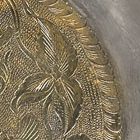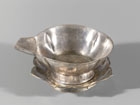J.J. Lally & Co., Oriental Art / New York City, New York
MenuPast Exhibition
Silver and Gold in Ancient China
March 16 – April 14, 2012
13.
A PARCEL-GILT SILVER POURING BOWL AND STAND
Tang Dynasty (A.D. 618 – 907)
the quatrefoil bowl with steeply rounded sides rising to an everted rim interrupted by a wide gutter-shaped spout and resting on a high ring foot, decorated on the interior with an engraved and gilded medallion of twin ducks with wings displayed, flying in a circle and each holding in its beak a scrolling stem sprouting twin flowers, trefoil leaves and scrolling tendrils, all reserved on a ring-punched ground and enclosed within a border of overlapping petals; the stand in the form of a large flower with shallow sides divided into eight wide petals radiating from an engraved ring of linked circles enclosing pointed bosses rising from a narrow gilded band, the gilded band with an inner diameter matching the diameter of the foot of the pouring bowl, the stand also raised on a high ring foot decorated with a gilded border of small engraved circles and the tips of the petals around the rim touched with gilding.
Length of pouring bowl with spout 7 inches (17.8 cm)
Diameter of stand 5 3⁄4 inches (14.5 cm)
Compare the parcel-gilt silver pouring bowl (yi) decorated with twin ducks and flower sprays on the exterior discovered in a Tang dynasty hoard at Hejiacun and now in the collection at the Shaanxi History Museum, illustrated in Hua wu da Tang chun: Hejiacun yibao jingcui (Selected Treasures from Hejiacun Tang Hoard), Beijing, 2003, pp. 244-247, no. 65, where the author cites one other silver yi from the tomb of Shui Qiu as the only comparable example, and states that silver yi vessels are very rare in the Tang dynasty.
The second Tang silver yi mentioned above, unearthed from the tomb of Shui Qiu in Lin’an, Zhejiang province, is illustrated as a line drawing by Han in Hai nei wai Tang dai jinyinqi cui bian (Selections of Tang Gold and Silver Wares from Inland and Overseas), Xi’an, 1989, p. 145, no. 284.
Compare the two gilt-silver flower-form cupstands with wide petal-lobed rims, one dated by inscription to A.D. 860, discovered in 1957 outside of Hepingmeng at Xi’an, Shaanxi province, illustrated in the excavation report in Kaogu, 1959, No. 11, pl. 6.
唐 鎏金鴛鴦花卉紋銀匜及鎏金蓮瓣銀托 匜長 17.8 厘米 托徑 14.5 厘米

